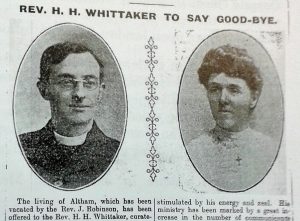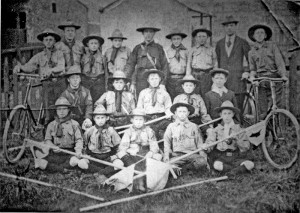Sandylands Scouts
Morecambe & Heysham’s First Scouts
One of the first groups of Scouts, if not the first, based in Morecambe & Heysham appears to have been at St John the Divine Church, Sandylands, Heysham. In the booklet “Scouting in Lonsdale” Peter Gedge included a photograph of the original Scout Masters’ Warrant issued to the Rev. H H Whittaker, Curate in charge at St John’s (1907-1909), and dated November 23rd 1908. Harold Hindle Whittaker was born at Stacksteads, near Haslingden, 8 May 1870. Rev. Whittaker left Morecambe in August 1909 to take up the living at Altham, near Accrington.

Certainly, I can find no reference in the Morecambe Visitor to any scouting activity prior to the following . . .
Heysham Chronicle – Local Notes
Morecambe Visitor & Heysham Chronicle dated November 4th, 1908
The scouting and gymnasium in connection with S. John’s Church appears to be making good headway, and it is certainly interesting to youths in the district.
Morecambe Visitor & Heysham Chronicle dated February 17th, 1909
The activity which is going on at present in connection with S. John’s Church is really remarkable. Almost each week sees something taking place. Their dramatic and musical recitals last week proved a great success and delighted many friends. There is an enthusiasm which is pleasing to witness, and the organisation of such functions cannot but do good to the Church and to the Sunday School.

Another point worthy of interest is the success of the Boy Scouts. Except those who are intimately connected with the work no one can realise what good they are capable of doing. The success of this movement is due largely to Mr Beckwith and although his natural modesty will resent being mentioned in this matter it is only fair to give honour and credit where it is due. His whole heart and soul is in doing good for the boys and he is certainly bringing them up to a high standard of perfection and training them in those qualities that will go to make them men in every sense of the word. We wish him success.
ST. JOHN’S CHURCH
Dramatic and Musical Recital
In aid of the Sandylands Boy Scouts dramatic and musical recitals were held in the S. John’s Parochial Hall on Friday and Saturday, and proved very entertaining and interesting. There was a good attendance on each day, and throughout there was an enthusiasm which was pleasing to witness.
The first part of the proceedings, on Friday opened with a pianoforte solo (a) Polonaise in E Flat minor (b) Valse C Sharp minor, by Bert Scott who certainly did the pieces justice. Pianoforte solos as a rule do not receive great enthusiasm, but in this case Mr Scott’s performance was very highly appreciated and he was accorded the most hearty praise for his effort. Miss Agnes Addison sang “Ma Curly Headed Babby” , while Mr Frank Oldfield contributed “The Storm Fiend” in such a fine fashion that the audience would not rest until he had responded to an encore.
Mr Joseph Wright of Bradford, who is certainly a fine elecutionist, and is always highly appreciated when he comes to S. John’s, gave an admirable recital of “Little Joe” from Dickens. Mr A. Watson, in a humorous song entitled “The Fireman”, caused roars of laughter. His get-up was very smart, and altogether he created a good impression. A violin solo by Miss Laura Proud was another appreciated item, as also was Miss Addison’s song “The Birthday Song”. Mr Frank Oldfield sang “Thy Foe”, and was again encored.
Not the least interesting part of the programme were the selections by a patrol of scouts including the scouts chorus and rally. The second part of the programme was the production of a comic drama entitled ‘A Rough Diamond’ and was given by Mr Scott (Lord Plato), Mr Walter Scott (Sir William Evergreen), Mr Bert Scott (Captain Blenheim), Mr Joseph Wright (Cousin Joe), Miss Gertrude Aldren (Lucy, a servant), Miss Theresa Booth (Lady Plato). Miss Edith A Blackburn (Margery). All the characters were well sustained, and all did their parts remarkably well There was no stiffness, everybody seemed easy and comfortable. Miss Edith A Blackburn played her part to perfection. She was most entertaining, and put the proper spirit into the piece. Altogether it was highly appreciated. Again, on the second evening, the pianoforte solos by Mr Bert Scott were very popular, and indeed they were so well rendered that he thoroughly deserved all the applause he received. Miss Agnes Addison’s splendid voice was heard to its best advantage in “Cherry Ripe” and later in the evening she sang “What’s in the Air to-day?” ” Three for Jack” was the name of Mr Oldfield’s first song, and once again he received an encore. A further recital by Mr Joseph Wright was highly appreciated.
Miss Laura Proud’s capabilities as a violinist were thoroughly tested in Van Biene’s “Broken Melody” and at the conclusion of her performance she was greeted with rapturous applause. On his second appearance, Mr Frank Oldfield was enthusiastically greeted, and he sang “Beloved Awake” to the entire satisfaction of the audience. Those who were present on the first evening thoroughly appreciated Mr A Watson, and he came in for a rousing reception, which however, was nothing compared with the applause mingled with laughter which he received at the conclusion of his humorous contribution.
The Scouts again had an apportunity (sic) for displaying their lusty young voices to the full advantage in a romping chorus. A comediette, entitled “Wooing One’s Wife” formed the second portion of the programme. Mr Bert Scott was a spirited and dashing Major Karl Von Walstein, and all the characters were admirably represented.
As a result of these recitals the funds of the Boy Scouts, who deserve every encouragement in their worthy object, should be considerably supplemented.
How times have changed . . .
Morecambe Visitor & Heysham Chronicle dated March 3rd, 1909
SANDYLANDS
BOY SCOUTS
The following contribution in reference to the Heysham Boy Scouts will be read with interest:-
It is impossible to thank individually all those who have “Done a good turn,” and of the untiring thought and care they have given to the welfare of the lads of the Boy Scouts of Sandylands. It should hardly be necessary to plead for their establishment, to argue in their favour, or to point out the elementary and obvious reasons for their value.
The following are the names of the 7 patrols now in existance (sic) at Sandylands, viz.: “Hounds,” “Peewit,” “Owl,” “Cuckoo,” “Kangaroo,” (cycle section) “Beaver,” and “Seal.” Each patrol has its own leader and corporal, and embraces altogether over 50 boys, who meet twice weekly, Tuesdays and Fridays, in the Parochial Hall, where there is for their use a splendid gymnasium, replete with all the necessary appliances.
For the purpose of elucidation, where there is amongst those not personally concerned with them, so much ignorance of their purposes and aims, and amongst those who are already interested in them, so hazy a conception of what those purposes and aims should be, and of the principles on which “Boy Scouts” must rest, some account of the work which they are at present doing, may not be altogether superfluous, we say, at present, in the belief that their sphere and scope will inevitably extend with time and experience, and thereby justify the belief that our “Young Bloods of today are the essential life-blood of the nation’s existence to-morrow.”
When a boy scout is being attested he is required to make the following oath, viz.:-
“On my honour I promise that I will do my duty to God and the King, I will do my best to help others whatever its cost to me. I know my scout law, and will obey it.”
The scouts motto is “Be Prepared,” which, as every scout knows to mean, that he is to be in a state of readiness in mind and body, to do his duty.
The following are a few extracts from the scout law:
1 – A scout’s honour is to be trusted.
2 – A scout is loyal to the King.
3 – A scout’s duty is to be useful and help others.
4 – A scout is a friend to all, and a brother to every other scout, no matter to what social class the other belongs.
5 – A scout is courteous.
6 – A scout is a friend to animals.
7 – A scout obeys orders.
8 – A scout smiles and whistles under all circumstances.
9 – A scout is thrifty.
To become a first and second class scout and gain the “Motto Badge,” a boy must satisfy his scout master in the following details:-
1 – Tie four of the following knots in less than thirty seconds each knot: Bow line, fisherman’s bend, reef knot, clove hitch, sheet bend.
2 – Track a deer’s “spoor” made with tracking irons, or a horse’s track for a quarter of a mile in not more than fifteen minutes; or in a town, to describe a shop window out of four observed for one minute each.
3 – Go at scout’s pace for one mile in not more than thirteen minutes.
4 – Know the scout laws and signs.
5 – Know the composition of the Union Jack, and the right way to fly it.
To become a first-class scout and gain the whole scout’s badge, a boy must pass the following test – in addition to those for second class scout (above) – before a Court of Honour:-
6 – Point out the direction of the points of the Compass where he stands.
7 – Make a journey alone of not less than fifteen miles from point to point, by walking.
8 – Describe or show the proper means of saving life in case of one (selected by the Court), of the following accidents:
Fire, drowning, runaway carriage, sewer gas, ice-breaking; or bandage an injured patient; or “revive” an apparently drowned person.
9 – Be able to read and write.
10 – Have at least sixpence in the Saving’s Bank.
11 – Show that he has brought a recruit to the boy scouts, and has taught him how to tie six principal knots.
12 – Lay and light a fire, using not more than two matches, and cook a quarter of a pound of flour and two potatoes without cooking utensils.
Badges of Honour are also given for certain tests.
Signalling – Ability to read and send Morse or Semaphore message, twenty letters a minute.
First Aid – For passing the St. John Ambulance tests in First Aid.
Stalking – Series of twelve photos of wild animals taken from life by the scout, and developed and printed by himself.
Merit – For twenty good marks for various good deeds.
It will thus be seen that to a boy scout no small effort is required by him, in order that he might become fully acquainted with the main principles upon which boy scouts are now being so extensively and permanently built, and the many benefits which must, of necessity, accrue to the lads, will be of a useful and lasting nature.
A SCOUT MASTER
Note:
There is an apparent contradiction here. According to newspaper articles in 1932, following the death of Arthur Peel, it is reported that he started the first Scout Troop in Morecambe in 1910. The above information, however, clearly shows that there was a Troop operating at St. John’s Church from 1908. The article above credits a Mr. Beckwith with being the prime mover, although, confusingly, the Scout Master’s warrant was issued to Rev. Whittaker and in the newspaper article published following his departure to Altham it is reported that he (Rev. Whittaker) “set on foot, and successfully carried on various organisations including boy scouts.”
In “Scouting in Lonsdale” Peter Gedge records that “Troops were also recorded as formed in Morecambe (the earliest registered being 1st (Sandylands) Morecambe under Robert Bright on October 11, 1910.” – more confusion!
According to the 1911 census Robert Bright was born c. 1882 in Whitby, North Yorkshire. In 1911 he was a Ship’s Engineer living at 20 Granville Road, Sandylands, Heysham with his wife Amelia, married in 1906 at St. Peter’s Heysham, and sons Edward, age 3, and Ronald, age 1 month.
1st Sandylands or 3rd Morecambe & Heysham?
In Morecambe Group numbers moved around the District as Groups came and went. Tracking the history of Groups is therefore somewhat challenging. Elsewhere, common practice was to take the next available number for a newly formed Group (as occurred in Lancaster, for example).
At the public meeting in October 1930 called to consider the formation of a separate Association for Morecambe among the Groups then existing is listed 1st Sandylands (seven Rovers, 13 Scouts, 11 cubs), G.S.M., Mr. W. Peel, A.S.M., Mr. S. Peel, cub Master, Miss Marion Peel.
A Meeting of the Morecambe Executive was held in the Imperial Hotel on the 23rd October 1930, the Chairman (Mr. J. Sly) being in the Chair, and this includes the following:
“An Application for Group Registration by the local Toc H Branch was next brought, and in view of the fact that the names of the Groups in the District were likely to get confusing, G.S.M. Peel proposed and Mr. F. Clayton seconded that the Group names be revised as follows:
1st Morecambe & Heysham. G.S.M. Whittles.
2nd Morecambe & Heysham. (Weslyan) (sic) A.S.M. Robinson.
3rd Morecambe & Heysham. (Sandylands) late 1st Sandylands G.S.M. A.Peel.
Etc.
Thus the 1st Sandylands became thereafter the 3rd Morecambe & Heysham Group, which was associated with St. John’s Church and met in the Parochial Hall.
Yet another ‘first’ claim:
Morecambe Guardian 17 December 1927:
PRIZE GIVING
A Happy Night at the Memorial Hall
INTRODUCED BOY SCOUTS.
During the interval, the Rev. E. Seymour Scott gave a short speech, introducing the Rev. R. G. Stanley, of Preston, who had come down to present the Sunday School prizes.
The Rev. R. G. Stanley said that it was with a sense of pleasure that he had come down to Morecambe. (continues)
Mr. Smith, the Sunday School Superintendent, proposing a vote of thanks, said that Mr. Stanley would be well known to the adults at the Morecambe Parish Church, and he would always be remembered as the man who introduced the boy scouts into Morecambe.
Robert G Stanley was born 6 February 1880 in Donnybrook, Dublin. In 1911 he was boarding at 149 Bell Lane, Bury with Joseph Robinson, a Head Teacher, & family where he was a Clerk in Holy Orders (Established Church), and Assistant Curate. In 1939 he was living at 5 Victoria Parade, Morecambe, a widower with his daughter Frances.
See also https://www.lonsdalescouts.org.uk/history/4th-morecambe-kings-own/

